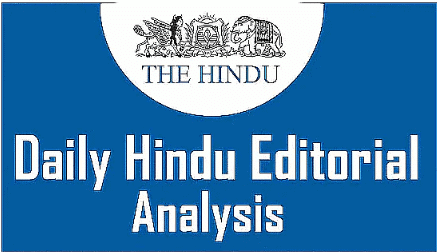UPSC Exam > UPSC Notes > Current Affairs & Hindu Analysis: Daily, Weekly & Monthly > The Hindu Editorial Analysis- 11th January 2025
The Hindu Editorial Analysis- 11th January 2025 | Current Affairs & Hindu Analysis: Daily, Weekly & Monthly - UPSC PDF Download

India’s Journey So Far on the AI Military Bandwagon
Why in News?
India is integrating AI into its military, focusing on modernization, but faces challenges in funding, policy, and interoperability.
India’s Advancements in Military AI
- Defence Budget 2023-24: ₹6.21 lakh crore ($75 billion) allocated for modernization and upgrading military systems.
- Innovative Developments: Introduction of products like the Indrajaal autonomous drone security system.
- Foreign Investments: Significant investments such as Microsoft’s $3 billion commitment to building data centres in Telangana, enhancing India’s AI ecosystem.
Government’s Commitment to AI in Defence
- Defence Minister Rajnath Singh: Highlighted AI’s potential to transform military operations through predictive analytics and autonomous decision-making.
- International Participation: India’s involvement in various global AI initiatives showcases its dedication to leveraging AI for defence.
- Need for Addressing Hurdles: Despite progress, certain challenges must be overcome for effective AI integration.
Challenges in Adopting Military AI
- Data Requirements: AI development necessitates vast amounts of digitized data and sophisticated data centres, which are costly and pose a challenge for India.
- Resource Allocation: The military needs to allocate resources for replacing outdated legacy systems, adding pressure to the budget.
- Legacy System Modernization: Outdated hardware, such as older aircraft, is no longer competitive on a global scale and requires urgent modernization.
Policy Gaps and Fragmentation
- Implementation Mechanisms: Current AI policies lack clear guidelines for military application.
- Strategic Documents: While documents like the National Strategy for Artificial Intelligence and the Responsible AI for All paper offer frameworks, they are not tailored for military AI deployment.
- Institutional Challenges: Bodies like the Defence Artificial Intelligence Council (DAIC) and the Defence AI Project Agency (DAIPA) need more transparent and updated progress reports.
Competitive Disadvantage
- Global AI Race: Nations such as Israel and China are advancing rapidly in military AI, putting India at a competitive disadvantage.
- Need for Vision: India requires a clearer strategic vision and faster implementation to keep pace in the global AI landscape.
- Strategic Caution: Leaders have raised concerns about the potential risks of AI, drawing parallels to the dangers associated with nuclear weapons.
Specific Challenges in India
- Inter-Service Silos: The distinct doctrines and communication systems of the Army, Navy, and Air Force impede interoperability and joint operations.
- Reliance on Public Sector Units (PSUs): The defence sector’s historical dependence on PSUs, despite capable private players and startups, slows down innovation.
- Need for Public-Private Partnerships (PPPs): Encouraging PPPs and competition, similar to advancements in the space sector, could boost AI innovation in defence.
Path Forward for AI in Defence
- Systemic Reforms: Addressing inter-service silos and reducing reliance on PSUs are crucial for effective AI integration.
- Strong Policy Frameworks: Clear and robust policies are necessary for the ethical and efficient deployment of military AI.
- International Collaboration: Engaging in global partnerships and fostering innovation through PPPs will enhance AI capabilities in defence.
- Strategic Cohesion:. unified strategy will enable India to fully exploit AI’s potential, transforming its defence landscape.
The document The Hindu Editorial Analysis- 11th January 2025 | Current Affairs & Hindu Analysis: Daily, Weekly & Monthly - UPSC is a part of the UPSC Course Current Affairs & Hindu Analysis: Daily, Weekly & Monthly.
All you need of UPSC at this link: UPSC
|
38 videos|5288 docs|1117 tests
|
FAQs on The Hindu Editorial Analysis- 11th January 2025 - Current Affairs & Hindu Analysis: Daily, Weekly & Monthly - UPSC
| 1. What are the key milestones in India's development of military AI technologies? |  |
Ans. India has made significant strides in the development of military AI technologies, including the establishment of dedicated research institutions, partnerships with private tech firms, and collaborations with foreign nations. Key milestones include the launch of various AI research programs by the Defence Research and Development Organisation (DRDO) and the introduction of AI systems for surveillance, logistics, and combat operations.
| 2. How is AI being integrated into the Indian military? |  |
Ans. AI is being integrated into the Indian military through the development of autonomous systems, data analytics for decision-making, and enhancing communication networks. Initiatives include using AI for predictive maintenance of equipment, improving battlefield awareness through drone technology, and employing machine learning algorithms for strategic planning and operational efficiency.
| 3. What challenges does India face in adopting AI for military applications? |  |
Ans. India faces several challenges in adopting AI for military applications, including technological gaps, limited infrastructure, cybersecurity threats, and the need for skilled personnel. Additionally, ethical concerns surrounding the use of autonomous weapons and the need for robust regulatory frameworks pose significant hurdles.
| 4. How does India's AI military strategy compare with other countries? |  |
Ans. India's AI military strategy is evolving but currently lags behind countries like the United States, China, and Russia, which have made extensive investments in AI for military applications. While India is focusing on indigenous development and collaborations, it still faces challenges in the speed of implementation and resource allocation compared to these leading nations.
| 5. What role does public-private partnership play in enhancing AI capabilities in the Indian military? |  |
Ans. Public-private partnerships are crucial for enhancing AI capabilities in the Indian military, as they facilitate collaboration between defense research organizations and private tech companies. This collaboration accelerates innovation, provides access to cutting-edge technologies, and helps in developing customized solutions for military needs, thereby strengthening India's defense capabilities.
Related Searches
















